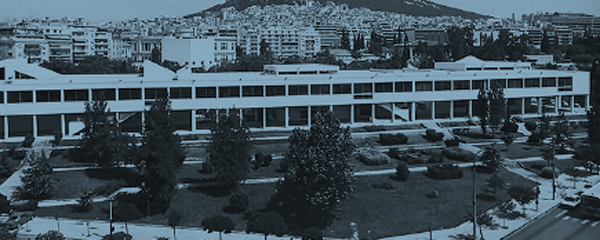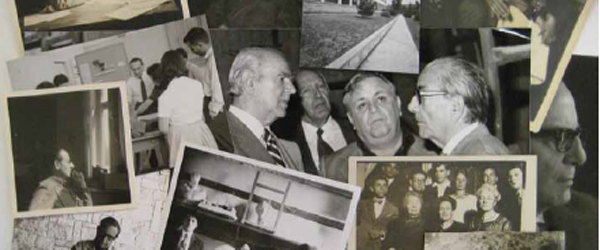ARCHITECTURAL REVIEW

The idea to pinpoint buildings that left their mark on the Greek capital's modern architectural and aesthetic history was obviously not a product of divine inspiration, as I had οoriginally thought, but was instead a latent need for me to satisfy my curiosity, as well as the curiosity of all those of you who share the same interest and have frequently discussed it with me. And so, let us discover the architectural surprises hiding in Athens.
The Battering Ram
The next step was to seek out a travel companion/architectural consultant - a young professional trained in the science of architecture who believes in "dynamic" architecture and whose research has a hand in shaping the future of the field, but who at the same time is familiar with the area's architectural history, respects it, and is inspired by it. We all know how the ancient Greeks encouraged people to take control of their fate with the saying "together with the goddess Athena, move your hand." In that spirit, my diligent search for an architect with publications as well as on-the-job experience was rewarded with the discovery of Dimitra Karampelia, an architect and founding member of the creative group Divercity, which was named as one of the top 30 up-and-coming new architectural offices in the world by Wallpaper Architects Directory in 2009. This recognition has been given to young professionals in Greece on only two occasions.
The Bauhaus School Revolution
And so, here is Dimitra Karampelia's proposal under the microscope: The Athens Conservatory, located on Rigillis Street and Vasileos Konstantinou Avenue. The building's facade measures 160 meters and it has a roof area of over 5,000 sq. meters, but its masterful design allows it to lose itself within its unique features. It is an exceptional example of the Bauhaus school and the modern movement in Greece. The Bauhaus school supplanted the increasingly unpopular use of the ornate and loquacious neoclassical style, as well as all the preceding movements' attempts to copy the architectural style of antiquity. Students of the Bauhaus school promoted the development of a building's structural system, allowing the heretofore mighty combination of form and shape to come about from the functionality of the structure's spaces. They made their designs based on mathematics and the help of the architectural grid, and they promoted the use of previously forbidden structural elements like concrete and load bearing structures, leading utility down the direction of fetish. For the first time, the study of architecture began to serve man and not "appearances."
A City, an Architect, and an Unrealized Dream
The creator of this architectural accomplishment was the worldly Jan Despo, also known by his birth name Ioannis Despotopoulos. He was born in Asia Minor in 1903 and studied at the National Technical University of Athens in 1921, completing his studies in Weimar, Germany in 1927 under the tutelage of the Bauhaus school's founder Walter Gropius, at a when this architectural style was flourishing. Afterwards, Despotopoulos went to work in Hanover as an assistant for the visionary Erich Mendelsohn. He was later exiled from Greece for his political beliefs, and in 1959, having already earned the recognition of European universities, he was awarded first prize for the idea he submitted to the urban planning contest for the Athens Cultural Center. He returned to his homeland after receiving this honor, but he never managed to rid himself of the "dangerous" liberal tag that followed all of the Bauhaus school's supporters - something that ended up costing him a place at the Academy of Athens. His complete proposal for the cultural center involved remodeling the space that stretches from Vassilissis Sofias Avenue to Vasileos Konstantinou Avenue, and from Rigillis Street all the way to the National Gallery, spanning an area of nearly 150,000 square meters. According to Despotopoulos' archives on file at the Modern Greek Architecture section of the Benakis Museum, which include 2,506(!) handwritten architectural plans and construction details, in addition to the Athens Conservatory, this grandiose plan foresaw the construction of an 1,800-seat opera house, a circular theater, an extension to the National Gallery, a new Byzantine Museum, a Byzantine-style church, a hotel, a hall for classical dance performances and the state orchestra, a playhouse for experimental theater, underground garages, separate smoking rooms (thought of 50 years ago!), and even a study dealing with how to configure public transportation! Despotopoulos' goal was to transform Athens into a capital that would be on par with the metropolises of Europe.

The Athens Conservatory
The lone treasure that exists as proof of the exceptionally composition that Despotopoulos put together is the renowned two-story Athens Conservatory. Those who rush to form an impression will see a simple, rectangular box. However, no visitor can resist the charm of the marble gate on the ground floor. Some of its other impressive features include the evocative length of the facade, the functional atriums, the openings revealing a view of Lycabettus Hill, as well as the refined, sometimes complex and futuristic, static solutions. The sections - a frequently overlooked aspect of study - prove themselves to be of "vital" importance here, as the unevenness of the roof allows the central rooms of this extended surface to receive natural light and air. What appears from a distance to be a simplistic design transforms the building into a grandiose structure from up close, including the dramatic lighting of its endless inner corridors, which are cut into pieces by the bright and dark areas which interchange in an almost musical rhythm. Inevitably, the Conservatory's features earn it a place among Greece's architectural accomplishments.
Visitors
"In order to achieve Completeness, the human factor is needed," says famous pianist and Conservatory director Aris Garoufalis. "Looking at the building from the outside, someone might fear that it is nothing more than a sterile Conservatory. But the pulse is vibrant and the simplicity of the areas invites the 850 students to unveil their unique talents without the slightest hesitation. A perfect example are the youngsters who take daily lessons in music kinetic education with the Orff method and transform the halls into a playground without the slightest inhibition." And to affirm this statement, I must admit that as soon as we entered the foyer, the classical music playing from the speakers made us feel at home, and as we were touring the building, we discovered rooms with scale models, masks, and constructions that evidenced passion that was at least equal to that of the exuberant Drama school students whom we met as they were practicing their show, or the dedicated "modern" musician who was preparing for an upcoming examination and wrestling with "classical" melodies. At present, the building also houses the National Museum of Modern Art. Every afternoon, the Conservatory is overrun by visitors who may just be dropping by, but who manage to completely conform to the environmental setting. These visitors include local skateboarders and hip hoppers, who now make up an inextricable part of the building's life despite their somewhat unusual appearance. In spite the director's objections, which arise from his worries about the damages that they are causing, the enthusiasm and immediacy with which he admitted that he is drawn in daily by this spectacle and the visitors' energy reveals that fortunately, outsiders continue to cultivate the uneasy spirit and wide-ranging of thought that characterized the ever memorable Ioannis Despotopoulos.

by George Rizopoulos
Article published in ''on air'' magazine.










